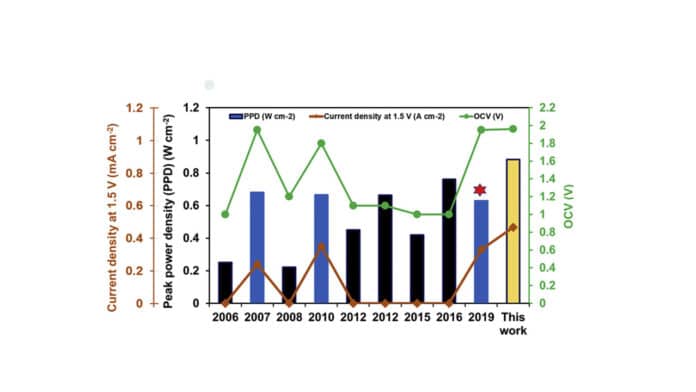Engineers at the McKelvey School of Engineering at Washington University in St. Louis have developed high-power direct borohydride fuel cells (DBFC) that operate at double the voltage of conventional hydrogen fuel cells.
Scientists have pioneered a reactant: identifying an optimal range of flow rates, flow field architectures, and residence times that enable high-power operation. This approach addresses critical challenges in DBFCs, namely proper fuel and oxidant distribution and the mitigation of parasitic reactions.
Significantly, they demonstrated a single-cell operating voltage of 1.4 or higher with peak powers approaching 1 watt/cm2. What’s more, doubling the voltage could lead to a smaller, lighter, more efficient fuel cell design, which translates to significant gravimetric and volumetric advantages when assembling multiple cells into a stack for commercial use.
Vijay Ramani, the lead author of the study, said, “The reactant-transport engineering approach provides an elegant and facile way to significantly boost the performance of these fuel cells while still using existing components. By following our guidelines, even current, commercially deployed liquid fuel cells can see gains in performance.”
Shrihari Sankarasubramanian, a senior staff research scientist on Ramani’s team, said, “Fuel cell manufacturers are typically reluctant to spend significant capital or effort to adopt new material. But achieving the same or better improvement with their existing hardware and components is a game-changer.”
Zhongyang Wang, a former member of Ramani’s lab who earned his Ph.D. from WashU in 2019 and is now at the Pritzker School of Molecular Engineering at the University of Chicago, said, “Hydrogen bubbles formed on the surface of the catalyst have long been a problem for direct sodium borohydride fuel cells, and it can be minimized by the rational design of the flow field. With the development of this reactant-transport approach, we are on the path to scale-up and deployment.”
Ramani added: “This promising technology has been developed with the continuous support of the Office of Naval Research, which I acknowledge with gratitude. We are at the stage of scaling up our cells into stacks for applications in both submersibles and drones.”
Journal Reference:
- Zhongyang Wang et al. Reactant-Transport Engineering Approach to High-Power Direct Borohydride Fuel Cells. Cell Reports Physical Science. DOI: 10.1016/j.xcrp.2020.100084
